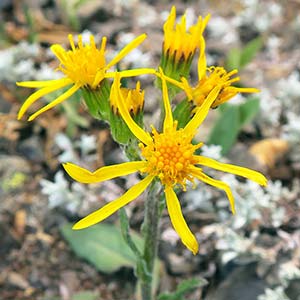Senecio lugens
Senecio eremophilus
black-tip groundsel, small blacktip ragwort
cut-leaf groundsel, desert ragwort, dryland ragwort, Elmer's butterweed
loosely, often unevenly, floccose-tomentose, glabrescent.
glabrous or glabrate.
single or clustered.
single or loosely clustered.
reduced distally; petiolate;
blades narrowly obovate to oblanceolate, (4–)8–18(–25) cm, bases tapered, margins subentire to dentate (denticles callous; mid and distal leaves bractlike, clasping).
± evenly distributed (proximal often withering before flowering); petiolate or sessile;
blades ovate or lanceolate to narrowly lanceolate, (3–)6–12(–20) × (1–)1.5–5(–7) cm, bases tapered, margins usually pinnate to lacerate, sometimes dentate.
(± 5) ± 8 (± 13);
corolla laminae 8–10(–15) mm.
± 8;
corolla laminae 5–10 mm.
(± 8) ± 13 (± 21), 4–7 mm, tips black.
(± 8) ± 13, 3–8+ mm, tips green or black.
of 2–5 linear bractlets (1–2 mm).
of 3–5+ (prominent or inconspicuous) bractlets (lengths to 3/4 phyllaries).
(2–)7–12(–20+) in corymbiform arrays.
10–60+ in compound corymbiform arrays.
glabrous.
usually glabrous, sometimes hirtellous.
= 40, 80.
= 38, 40, 44.
Senecio lugens
Senecio eremophilus
Senecio lugens varies greatly in robustness across its range. It is scattered widely in the Rocky Mountain uplift and adjacent regions from northern Wyoming to Alaska; it is disjunct in the Olympic Peninsula, Washington. Superficially similar to S. integerrimus, S. lugens has well-developed, coarse, spreading rootstocks with branching roots; S. integerrimus arises from foreshortened, buttonlike caudices with abundant unbranched, fleshy-fibrous roots.
(Discussion copyrighted by Flora of North America; reprinted with permission.)
Varieties 3 (3 in the flora).
Varieties of Senecio eremophilus are distinguished by head size and distribution. Varieties eremophilus and macdougalii are notably different; var. kingii is intermediate in both morphology and distribution.
(Discussion copyrighted by Flora of North America; reprinted with permission.)
1. Calyculi: bractlets prominent (lengths of at least some to about 3/4 phyllaries); involucres 7–10 mm diam.; phyllaries 6–8 mm, tips green or weakly, if at all, black | var. eremophilus |
1. Calyculi: bractlets conspicuous or inconspicuous (lengths rarely to 1/2 phyllaries); involucres 5–8 mm diam.; phyllaries 3–6 mm, tips usually black | → 2 |
2. Calyculi: bractlets conspicuous (lengths to 1/2 phyllaries); involucres (5–)6–8 diam.; phyllaries ± 13, (4–)5–6 mm | var. kingii |
2. Calyculi: bractlets inconspicuous; involucres 4–5(–6) mm diam.; phyllaries ± 8 or ± 13, 3–5 mm | var. macdougalii |


